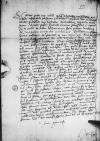Letter #330
Cornelis DE SCHEPPER to Ioannes DANTISCUSFraga, 1527-04-12
English register:
De Schepper reassures Dantiscus that he is looking after the Chancellor [Mercurino Gattinara] during the journey. He caught up with the Chancellor [who left court for Italy at the end of March]. The Chancellor is generally lauded by the Spanish and their confidence in him is so great that some even blame De Schepper for advising his journey to Italy.
De Schepper comments on political and diplomatic issues, and on the career of some persons at the imperial court.
They have been in Zaragoza and they have now reached the place that witnessed the Battle of Lerida which took place between the armies of Caesar and Pompey. They will celebrate Palm Sunday in Lerida, from where De Schepper will write a more copious letter.
He asks Dantiscus to keep him informed about the situation at court.
| received Valladolid, [1527]-04-28 Manuscript sources:
Auxiliary sources:
Prints:
| ||||||||||
Text & apparatus & commentaryPlain textText & commentaryText & apparatus
Magnifico et
exc(ellentissimo) or exc(ellenti)⌈exc(ellentissimo)exc(ellentissimo) or exc(ellenti)⌉
Domino
Salutem.
Credere potes me nihil operae diligentiaeque omisissem, quo meum ass written over e⌈ess written over e⌉equerer plus quam ms. plusquam(!)
⌈plus quamplus quam ms. plusquam(!)
⌉ parentem. Quarto die ab incepto itinere prehendi iam lassatum itineratione, vegetum tamen
Vicecancellarius encrypted ⌈
Ex
Tuus, quem nosti,
[1]
Vicecancellarius symbol [S1] (double gibbet) used for Baltasar Merklin von Waldkirch; the solution of the cipher based on Dantiscus’ solution of De Schepper’s use of this symbol preserved together with the fair copy of cf.
[2] Lalmant (arrow right symbol): the solution of the cipher is based on Dantiscus’ solution of De Schepper’s use of this symbol, as preserved together with the fair copy of cf.
[3] caesarem (symbol A): the solution of the cipher is based on Dantiscus’ solution of De Schepper’s use of this symbol, as preserved together with the fair copies of cf.
[4] Italiae (symbol X): the solution of the cipher is based on Dantiscus’ solution of De Schepper’s use of this symbol, as preserved together with the fair copies of cf.
[5]
caesari (symbol A): the solution of the cipher is based on Dantiscus’ solution of De Schepper’s use of this symbol, as preserved together with the fair copies of cf.
[6] regis Angliae (symbol Q): the solution of the cipher is based on Dantiscus’ solution of De Schepper’s use of this symbol, as preserved together with the fair copy of cf.
[7] Pontifex(?) encrypted with the symbol B, which appears also in cf.
[8]
viceregem (symbol S): the solution of the cipher is based on Dantiscus’ solution of De Schepper’s use of this symbol, as preserved together with the fair copy of cf.
[9] The Battle of Illerda (49 BC) was a series of military actions near Illerda (now Lleida/Lerida) in the Civil War between Caesar and Pompey. It resulted in the surrender of Lucius Afranius and Marcus Petreius, the commanders of Pompey’s army, to Caesar, and thereafter, the surrender of Marcus Terentius Varro, praetor of Hispania Ulterior.
[10] In 1527 Palm Sunday fell on April 14.
[11] To be added later: which of the counts palatine were at the court of Charles V at that time.


 BCz, 243 p. 76
BCz, 243 p. 76